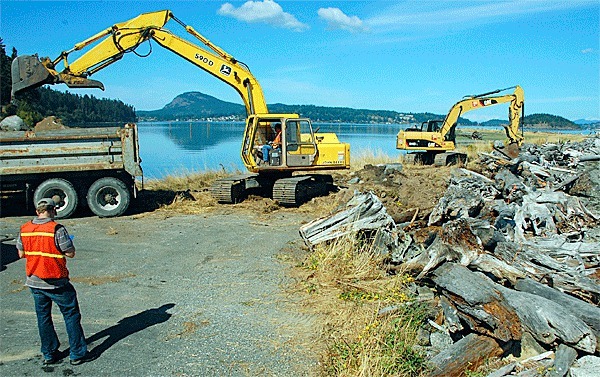Restoration work on Ala Spit, a popular county park in North Whidbey, began in earnest Monday with loaders removing many tons of boulders.
The project, which will close the park to the public until the end of October, seeks to fix a complex erosion problem that is believed to be the result of riprap installed at the spit in the late 1960s. It’s also hoped to protect long-term public access and restore juvenile salmon habitat.
Although several years in the making and based largely on science in a study performed by Herrera Environmental Consultants, a regional consulting firm, the restoration project has sparked concerns among anglers and neighbors alike.
On Saturday, project leaders from Island County Public Health held a question and answers forum at the park. Attended by a handful of people interested in learning more about the project, along with two county commissioners, the meeting appears to have been successful as it soothed some concerns.
Penny Andrukat, who lives about one mile from the park, was worried that removing rip-rap — a shoreline armoring technique designed to prevent erosion —ì would result in a breach of the spit and reduce public access.
Hearing the county’s explanation of how the rip-rap is actually doing the opposite of its intended purpose was enlightening, she said. Their verbal assurances meant a lot, but she still has reservations about later phases of the project.
“I’m relieved but wary about the bulkhead,” Andrukat said.
The work being performed now will remove large boulders and chunks of crushed concrete along the first 800 feet of the spit’s neck, but a later phase of the project proposes to remove a bulkhead and rock groin south of the parking lot.
Some are concerned its removal will have an adverse effect on the parking lot and spit, especially during the winter months when the area is pounded regularly by wind, heavy surf and driftwood.
Jill Wood, environmental health director for public health, could not be reached for comment but said in an earlier interview that the area wouldn’t be left bare but protected with what’s called “soft armoring.” Rather than concrete, it uses a mix of gravel, sand and logs to protect the shoreline.
Also, the third phase of the project is subject to available funding and there is no schedule of when the work might take place. However, Wood said the hope is that it could be completed within the next two years.
While she is feeling better about the work that will be performed over the next month, Andrukat said she thinks the county could have done a better job alerting the public to its plans. She said she hopes any third phase of work would be better publicized so the community can make its concerns clear.
For more information about the project, call 678-7888 or visit www.islandcountyeh.org/Projects.



